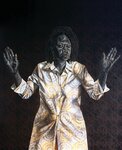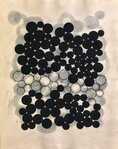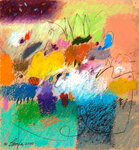





In a time of death and unrest amid a brutal pandemic, Tim McFarlane wondered if his art was enough.
He was a Black artist during a period when the social and political upheaval of the times demanded commentary. If his swirling abstract images weren’t representational depictions of the period’s pain and anxiety, was he fulfilling his responsibility as a Black artist?
His answer, in the densely packed and saturated paintings he created to portray the uncertainty and angst of the times, was yes.
“It almost felt like you took a step and there were a thousand things happening. You had news coming at you online. There was stuff happening in real-time,” McFarlane said. His art in those moments “was me trying to work through all these different levels of experiences, happening all at once.”
Those experiences and the work created by 71 other artists during the unprecedented 17 months that began with COVID, and encompassed Black Lives Matter protests, are the focus of a newly released book, “Shifting Time: African American Artists 2020-2021.” A compendium of art, essays, reflections and memorials, the book will be the focus of a discussion and book signing Saturday, July 22, at Woodmere Art Museum in Chestnut Hill.
Art consultant Dr. Klare Scarborough and artist Berrisford Boothe, who co-edited the book, will lead a short discussion. At least 20 of the 72 artists featured in the book are scheduled to attend, including Philadelphia-area-based artists Barbara Bullock, Charles Burwell, James Brantley, Syd Carpenter, Martina Johnson-Allen and Richard J. Watson.
Scarborough, who approached Boothe with the idea for the project, called the period between March 2020 to mid-July 2021 “a time like no other” and “a generational shift where everything changes.”
The period was marked by the devastation of COVID, coupled with the police-involved deaths of African Americans including Breonna Taylor and George Floyd, the protests that followed and the Jan 6th insurrection in Washington, D.C. Scarborough and Boothe brainstormed about what that meant for artists.
“The feeling that we are tethered to normalcy was warping and none of us knew how it would play out,” said Boothe, a professor at Lehigh University who views the period as a time shifter, the way people reflect upon where they were on D-Day or Sept. 11. Artists, as chroniclers of history, are then called on to interpret the period and create art out of it. In “Shifting Time,” the works speak to their own experiences of loneliness, their anger at police brutality, or their fear of death.
Artist Curlee Raven Holton’s watercolor “Hands Up” documents the symbol of “hands up” as a sign of self-defense and protest against police brutality. “Yellow as Gold,” the cover art by Morel Doucet and Stephen Arboite explores community displacement by incorporating local plants, leaves and flowers. At the same time, Barbara Bullock’s vibrant collaged faces represent the spirit of survival through a series of painful events.
Artists speak
Before beginning the collaboration with Scarborough, Boothe had begun his own exploration of the artists’ experience during that period in a series of virtual arts salons he called “Shuga and Wata,'' a reference to Boothe’s Jamaican heritage and a popular drink of sustenance. The digital discussion, meant to connect artists at a time of unsettling separation, tackled such topics as “Radical Forgiveness” and “Deconstructing and Transforming Race in America.” “Shifting Time'' includes excerpts from several of the online sessions.
The book is a project of the Philadelphia-based Petrucci Family Foundation, founded in 2006, which highlights African American visual creativity and its role in the history and discourse of American art. The book and its themes align seamlessly with the foundation’s commitment to contemporary African American artists and the mission of ensuring that their talents, perspectives and contributions are elevated and historically documented, said Claudia Volpe, director at the Foundation.
More than 200 artists submitted works to be considered for the book, 72 were selected and nearly 20 are from Philadelphia. The publication includes two works by each artist, an artist statement and sections for essays and memorials to artists who died during the period, including Emma Amos, David Driskell and Philadelphia artist Moe Brooker.
In the book, artist Lavette Ballard writes about a year that starts off with high hopes, only to be derailed like “Pigpen from Charlie Brown at an all-white party.” Ify Chiejina, who was hospitalized during COVID, discusses creating during her recovery and trying to “reconnect” with her heart as she sketched.
“We recognized immediately the importance of this book to our community and the recent history of COVID,” said William Valerio, Woodmere’s CEO and director. The book also helps counter a history in which Black artists were not represented in museums, books and other platforms, he said, and “‘Shifting Time’ shines a light on artists that we ought to be paying attention to. The book is incredibly important in that way.”
The “Shifting Time” book signing will be from 4 to 5:30 p.m. The event is free. To RSVP, email amonroe@woodmereartmuseum.org. A limited number of books will be available for purchase for $30. Woodmere Art Museum is at 9201 Germantown Ave.